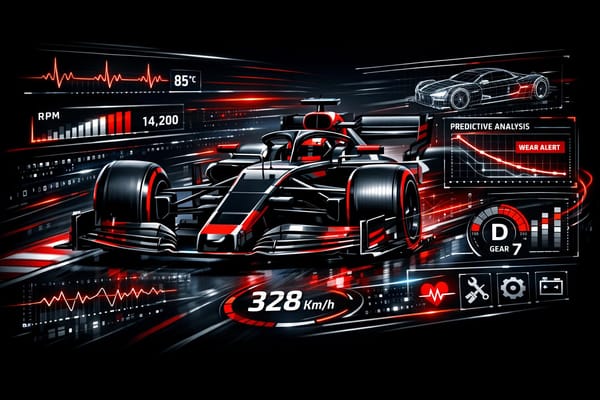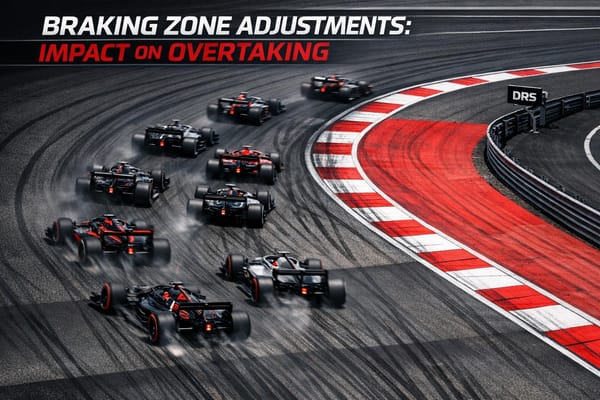Discover the Most Challenging F1 Tracks of All Time
Explore the toughest F1 tracks that challenge drivers' skills and strategies, from Monaco's narrow streets to Spa's unpredictable weather.
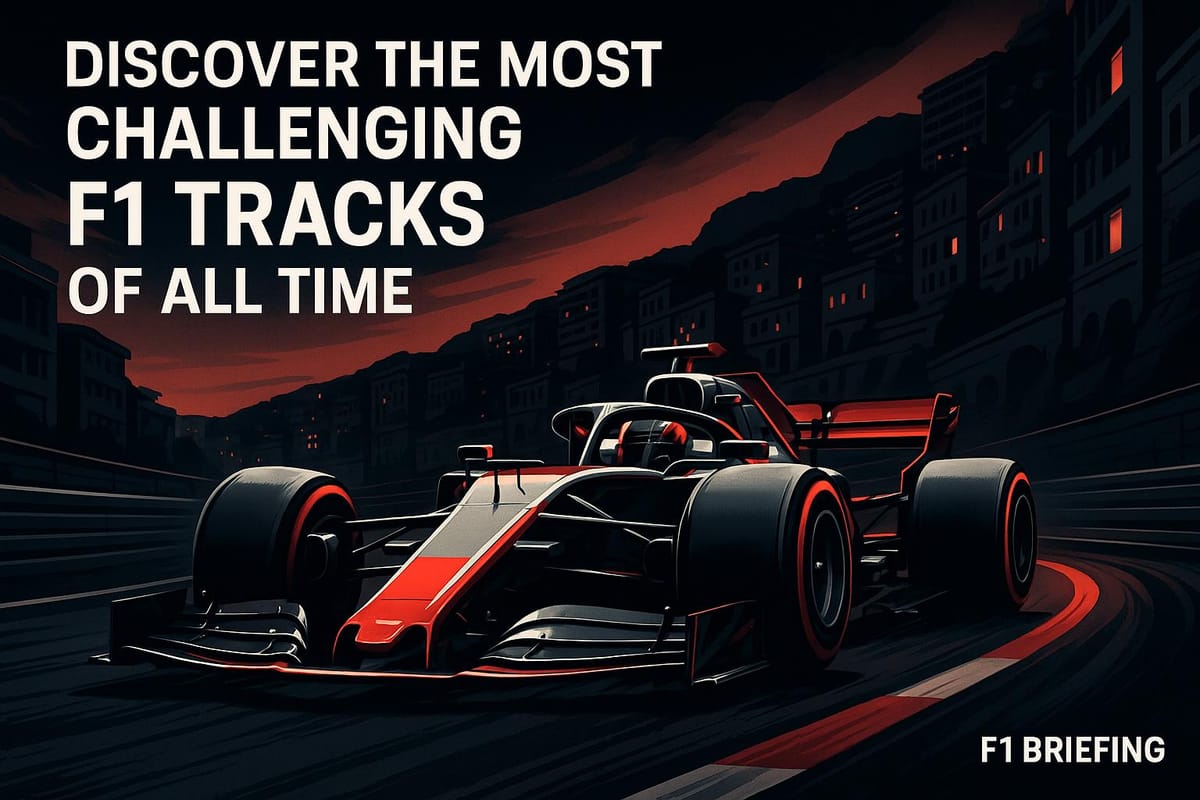
Formula 1 tracks are designed to test every aspect of a driver’s skill, endurance, and strategy. Some circuits, however, stand out as the most demanding in the sport's history. Here's a quick look at five of the toughest:
- Monaco: Narrow streets, sharp elevation changes, and almost no room for error make overtaking nearly impossible.
- Spa-Francorchamps: Known for its 335-foot elevation changes and high-speed sections, it requires both bravery and precision.
- Singapore (Marina Bay): A grueling night race with extreme heat and humidity, pushing drivers to their physical limits.
- Hungaroring: Often called "Monaco without barriers", its tight, twisty layout makes overtaking a nightmare.
- Silverstone: High-speed corners and unpredictable weather challenge both drivers and engineers.
Each of these tracks presents unique hurdles, from technical layouts to extreme conditions, making them iconic in F1's history. Below, we dive into what makes these circuits so challenging.
RANKING every F1 track from EASIEST to HARDEST
1. Circuit de Monaco
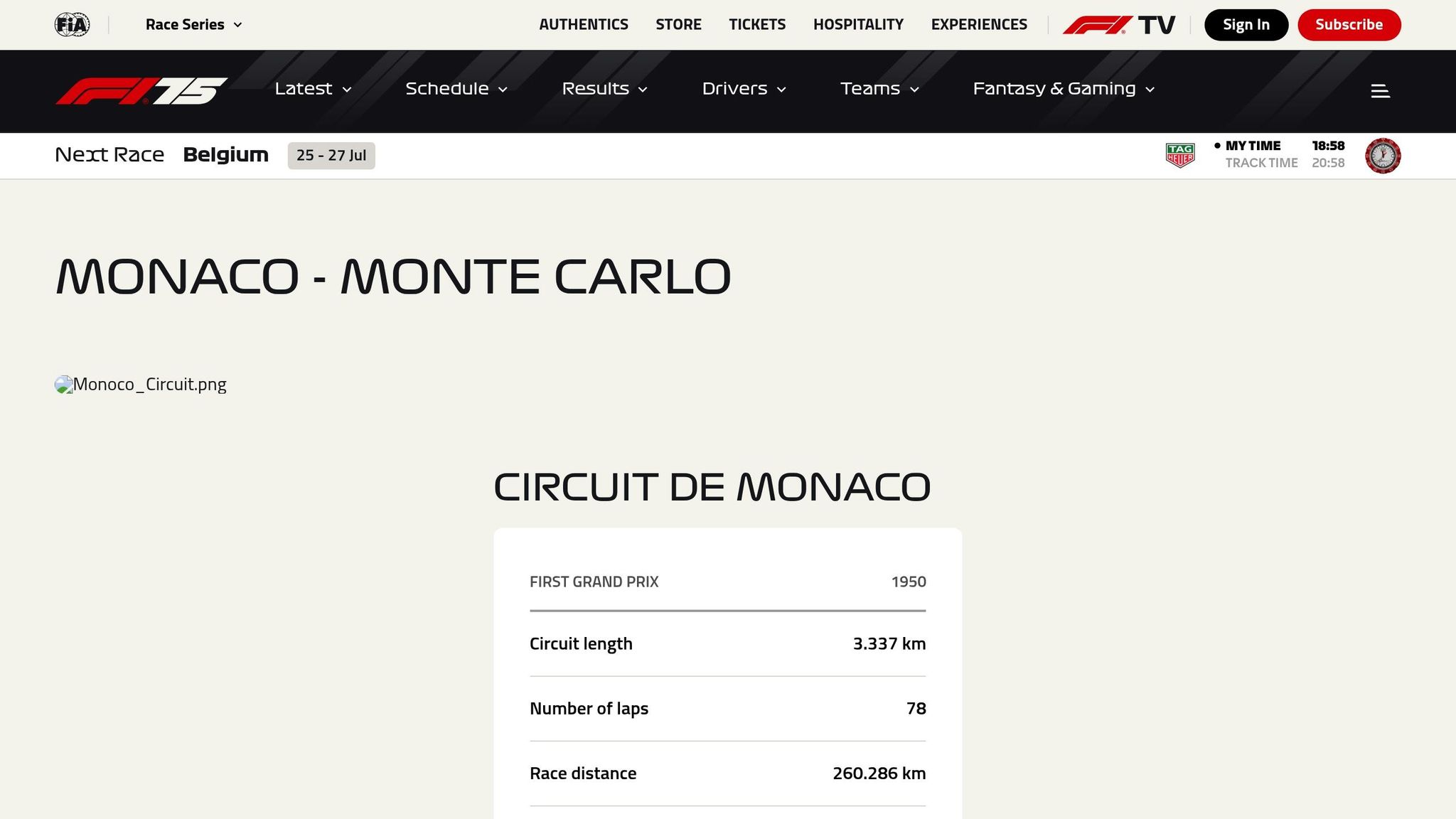
Monaco's circuit is a true test of skill, demanding razor-sharp precision as drivers navigate its narrow, twisting streets. Stretching just 2.07 miles, this street circuit winds through the heart of the principality, earning its reputation as one of the most challenging tracks in Formula One. Nelson Piquet once famously likened it to:
"riding a bicycle around your living room".
A Layout Packed with Technical Challenges
Monaco's design pushes drivers to the limits with its abrupt speed changes and unforgiving corners. The Fairmont Hairpin, for instance, forces cars to slow to a crawl at just 30 mph - making it the slowest corner in Formula One. Yet moments later, they’re rocketing through the tunnel kink at speeds of up to 160 mph. Each lap requires an astonishing 47 gear changes, and with a 138-foot elevation difference between the circuit’s highest and lowest points, drivers face steep climbs, sharp descents, and sudden lighting changes within the tunnel. These elements combine to create a track that demands exceptional technical skill.
Track Position: The Ultimate Battlefield
In Monaco, qualifying is everything. The circuit's narrow layout makes overtaking nearly impossible, as highlighted by the 2003 Monaco Grand Prix, which saw zero on-track overtakes. Teams often prioritize qualifying performance over race pace, knowing that starting position can dictate the outcome. Strategies like undercuts and overcuts during pit stops become critical tools for gaining positions, as even the smallest advantage can make or break a race.
A Grueling Test of Physical and Mental Strength
The Monaco Grand Prix is as much a test of endurance as it is of skill. Drivers endure cockpit temperatures soaring to 122°F and maintain an average heart rate of 182 bpm throughout the race. The relentless G-forces - reaching up to five times gravity - add to the physical toll. As Lewis Hamilton once described:
"Most often, it's just sheer luck. Throw it into the corner and come out with your eyes open. And hopefully you've made it round.".
Adding to the challenge, drivers can lose up to 5% of their body weight through sweat during the race. With the circuit’s unforgiving Armco barriers, even the smallest lapse in concentration can lead to disaster.
Car Setup: Prioritizing Downforce Over Speed
Monaco demands a unique approach to car setup. Teams prioritize maximum downforce to ensure grip through the slow-speed corners, even at the expense of straight-line speed. Stability under braking is crucial, given the frequent heavy-braking zones and the precision needed for cornering. While engine performance takes a backseat, aerodynamic efficiency and chassis balance are key to tackling the circuit's steep climbs and sharp turns. Suspension tuning is equally critical to handle the varying speeds and tight corners.
Charles Leclerc, a native of Monaco, summed up the track’s allure:
"Monaco is so specific that we need to start a little bit from a blank page... Now it's in a Formula One car. So that makes it extra special for me. So I'm really looking forward to it. To be in Monaco, a very special track I think for every driver because it's a very challenging track and extra special for me, as it's my home race.".
This intricate blend of technical challenges, strategic demands, and physical endurance makes Monaco a standout circuit, setting the stage for drivers to showcase their absolute best.
2. Circuit de Spa-Francorchamps

Nestled in the heart of the Ardennes, Spa-Francorchamps is a true test of speed, precision, and endurance. Stretching 4.35 miles, it holds the title of the longest circuit on the current F1 calendar. With 19 corners and dramatic elevation changes totaling 335 feet, this track demands unwavering focus and mastery from drivers. Its varied layout challenges every aspect of Formula One performance, with the iconic Eau Rouge complex standing as its most celebrated feature.
The Legendary Eau Rouge and Raidillon Complex
The Eau Rouge and Raidillon complex is the beating heart of Spa's challenge. Drivers plunge into Eau Rouge before climbing a steep 17% gradient, gaining 134 feet in elevation. This sequence subjects both car and driver to forces reaching 4G, pushing them to their absolute limits.
Oscar Piastri perfectly summed up the magic of this corner:
"The first time you go up Eau Rouge, it's always very, very special, no matter what car you're in... there's never really going to be a track like Spa again, through the middle of a forest, and I think that definitely adds to the atmosphere of it, and the undulation and stuff like that. We're not going to have racetracks like that again. So I think that's why it's so special."
Full-Throttle Intensity and High-Speed Commitment
Spa is relentless. Drivers spend about 72% of each lap at full throttle, including an intense 24-second stretch of flat-out racing. The Kemmel Straight is a prime example, with cars hitting top speeds of around 211 mph. Meanwhile, corners like Blanchimont demand precision and bravery, as drivers navigate a near-flat-out left-hand kink that tests both downforce and control.
Charles Leclerc highlighted the track's unforgiving nature:
"I really like the flow of the track... Pouhon is such a challenging corner, much more than it was in the past, because we are going at such speeds, and it's not flat yet... I will consider it still a very challenging track, with quite a lot of high speeds... the way the track is laid out, with the grass quite close, it puts you in a place where you cannot afford to do a mistake, and you pay for it. So this is something that we always enjoy as drivers."
Weather: The Ultimate Wild Card
Spa is notorious for its unpredictable microclimate, which adds an extra layer of complexity. With 40% of races held in rainy conditions, teams must constantly adapt to shifting weather patterns across the circuit’s 4.35-mile length. It’s not uncommon for one section of the track to be drenched in rain while another remains completely dry. This creates a constant challenge for tire strategy and quick decision-making.
Sudden downpours can completely alter the course of a race, often benefiting underdog teams and reshaping championship standings. For teams and drivers alike, Spa’s weather is a game of high-stakes strategy.
Engineering and Setup Challenges
The technical demands of Spa-Francorchamps extend beyond the drivers. Engineers face a unique puzzle: balancing setups for high-speed straights like the Kemmel Straight while ensuring precision through technical corners like Les Combes. The track’s varying grip levels and unpredictable weather further complicate car setup, requiring constant adjustments.
Giampaolo Dall'Ara, Head of Track Engineering at Sauber F1 Team, described the challenge:
"Spa-Francorchamps is a circuit that offers a real challenge both for drivers and engineers."
Rémi Taffin, Head of Track Operations at Renault Sport F1, added:
"If Monza has a higher percentage of full load, Spa remains a bigger challenge because the corners are much more varied with altitude changes over a seven-kilometer lap."
This intricate balance of speed and precision makes Spa a proving ground not only for drivers but also for the engineering teams behind them.
A Driver's Ultimate Test
Max Verstappen’s straightforward reflection captures Spa’s timeless appeal:
"It's still, for me, my favourite track. Every time I go there, the layout with all the flowing corners. I think it's very nice."
Spa-Francorchamps remains a place where high-speed courage, technical skill, strategic brilliance, and adaptability converge. It’s a circuit that rewards only the most complete drivers and teams, making it a cornerstone of Formula One excellence.
3. Marina Bay Street Circuit (Singapore)
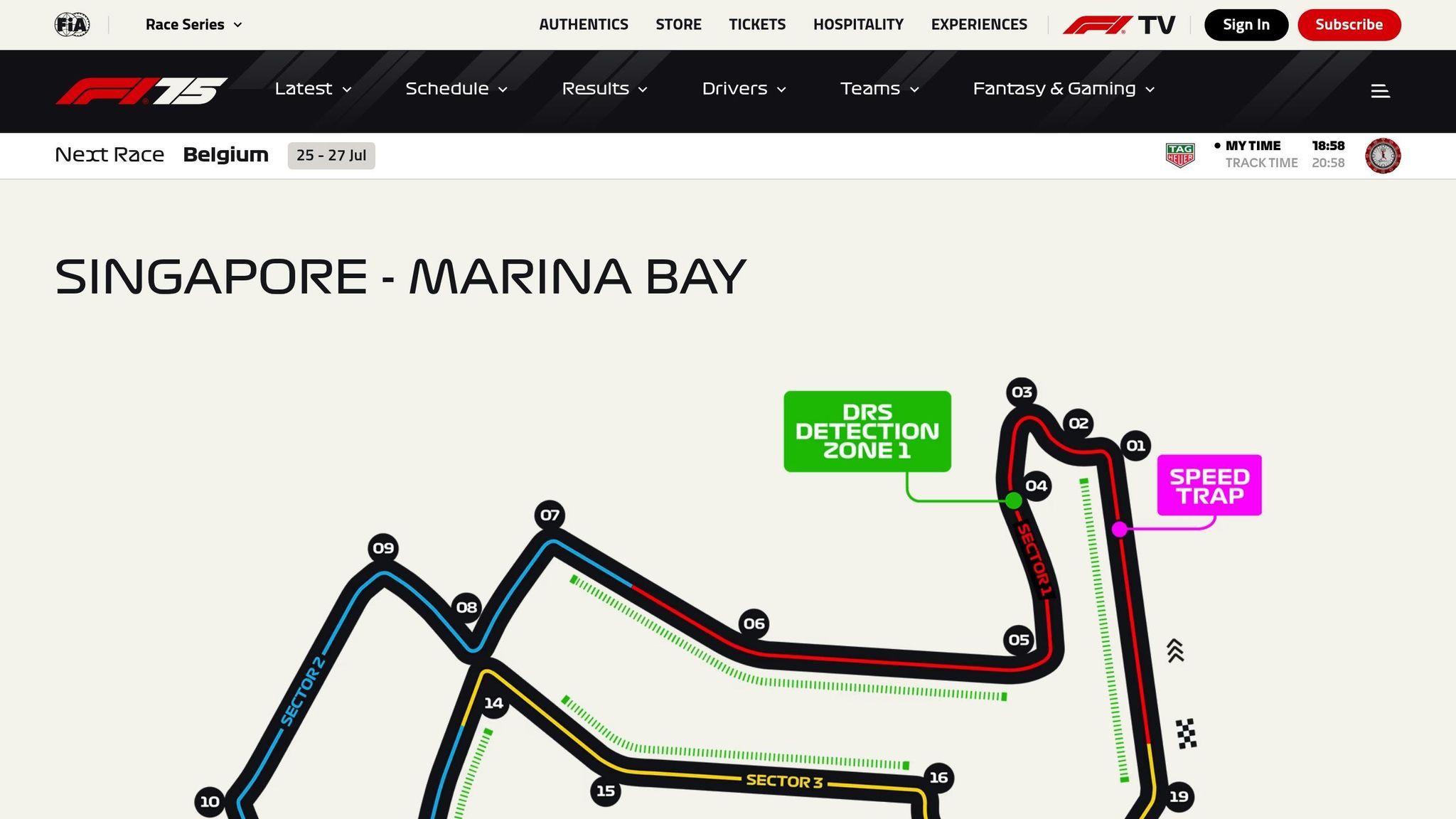
Singapore’s Marina Bay Street Circuit is a true test of endurance, blending complex technical demands with intense physical challenges. This 3.07-mile track, featuring 19 tricky corners, pushes drivers to their limits. Beyond its intricate layout, the circuit's nighttime setting adds another layer of difficulty, making it one of the most grueling stops on the Formula One calendar.
The Physical Gauntlet
When it comes to physical intensity, no other circuit compares to Singapore. Drivers face blistering ambient temperatures of over 104°F, with cockpit temperatures soaring to about 140°F, all while battling humidity levels above 70%. These extreme conditions often cause drivers to lose up to eight pounds (3.6 kg) of body weight in a single race. Lewis Hamilton has described the circuit as twice as demanding as Monaco, requiring significantly more energy per lap.
Nico Rosberg, who won the 2016 Singapore Grand Prix, painted a vivid picture of the heat:
"I would lose eight pounds (3.6kg) of bodyweight from sweating. It's like you're in a skiing suit, while sitting on asphalt which is 45 degrees. Then you have the petrol right behind you, which is 65 degrees, so it's extremely hot."
The relentless nature of the race keeps drivers’ heart rates at an average of 135 beats per minute, with some losing up to a liter of sweat during the session.
Night Racing Complications
As the first Formula One night race, Singapore introduced a unique set of challenges. The track is illuminated by over 1,600 lighting projectors producing 3,000 lux, but even this impressive setup comes with its own issues. Reflections and glare, particularly in wet conditions, can make visibility tricky. The nighttime setting also impacts track temperatures and grip, forcing teams to rethink tire strategies and car setups to adjust to these unusual thermal conditions.
Technical Demands and Strategic Complexity
The Marina Bay layout demands precision and consistency. With 19 corners packed into 3.07 miles, drivers have minimal room for error. Lap times here are among the longest in Formula One, second only to Monaco. The circuit’s design requires cars to run with a higher ride height, which can disrupt aerodynamics and create additional setup challenges. Nico Rosberg once noted:
"You have the seatbelts really tight, so you can hardly breathe properly. You have to hold your breath in the corners."
Adding to the difficulty, the high-grip surface accelerates tire wear, making tire management a critical part of race strategy.
Endurance and Time Limits
Singapore’s reputation as one of the toughest races is reinforced by its duration. The two-hour race time limit has been reached multiple times, and no Singapore Grand Prix has ever been completed in under one hour and 51 minutes. Fernando Alonso summed up the challenge:
"The walls will be the limitation here, and it's probably the most demanding race, physically, of the championships. So keep the level of focus very high throughout the race."
George Russell shared a similar view:
"It's the top two, here and Qatar are by far the most physical races. I think here it's challenging because there are so many corners, pretty relentless."
Preparation and Adaptation
Surviving the Marina Bay Street Circuit requires meticulous preparation. Drivers increase their caloric intake by 3,500 calories to counteract energy loss, while teams use cooling measures like vests, frozen towels, and ice baths to help drivers manage their core temperatures. Martin Poole, Nico Hulkenberg’s performance coach, highlighted the importance of planning:
"We've had our eye on Singapore since the start of the summer break."
Daniel Ricciardo also reflected on the circuit’s intensity:
"I didn't realize how much the humidity and the relentless nature of that circuit with like no real straights to have a rest. I'd never really experienced anything like that."
The Marina Bay Street Circuit stands as a grueling challenge where technical skill and physical endurance collide. Success here demands not only talent but also immense preparation, making it a true test for the best in Formula One.
4. Hungaroring

The Hungaroring, often referred to as "Monaco without the barriers", is a track that demands finesse, precision, and strategic thinking. Its tight, twisting 2.722-mile layout with 14 corners challenges drivers in ways few other circuits can.
The Karting Track Challenge
This circuit's layout is reminiscent of a karting track, where one tight corner leads directly into another, leaving drivers with little opportunity to unleash full throttle. As Rémi Taffin, Track Operations Director of Renault Sport F1, puts it:
"This winding 4.381 km circuit is often compared to a karting track, with one slow corner following another. This nature results in an extremely low average speed, with only 182 km/h. It is the slowest track of the season after Monaco. In fact, with only 55% of the lap spent at full throttle, the demands of this permanent track are very similar to those of an urban circuit."
With an average speed of just 113 mph and only 55% of the lap spent on full throttle, the Hungaroring prioritizes precision over outright speed.
Overtaking Nightmare
Passing at the Hungaroring is a well-known headache for drivers. During the 2023 race weekend, only 51 overtakes were recorded. Former Renault F1 driver Jolyon Palmer highlights the difficulty:
"In the race, you've got to think about setting up your overtake coming out of Turn 14, the final corner, because that is your one chance to do something into Turn 1 and, if not, into Turn 2. If you don't get it done there, you're probably going to be following for the next lap."
The narrow racing lines and relentless twists leave little room for bold moves, making a strong qualifying performance crucial.
Heat and Tire Management Crisis
Hungary’s blazing summer heat adds another layer of complexity. During the 2023 Hungarian Grand Prix, track temperatures reached a scorching 127.4°F - the hottest recorded that season. These conditions wreak havoc on tires, as Pirelli warned:
"Degradation can be high, especially when it is very hot and the forecast for this weekend is definitely not [favorable] in this regard... Overheating is therefore a factor that needs to be kept under control, not just in the race but also in qualifying."
Pierre Gasly acknowledged the toll such heat takes on drivers, making every lap a test of endurance and focus.
Technical Setup Demands
The Hungaroring’s unique challenges force teams to adopt car setups similar to those used in Monaco, prioritizing maximum downforce. Tom McCullough, Track Engineering Manager of the Sauber F1 Team, explains:
"The Hungaroring is a real challenge for drivers and engineers, as it is one of the most technical circuits on the calendar. The track layout results in a high percentage of time spent in corners. This means the level of downforce required is similar to that of Monaco. There are many long corners that are smooth, with the majority taken at low and medium speed. Qualifying position is important because overtaking is always difficult even with the use of KERS and DRS."
Adding to the difficulty, the track’s limited airflow presents cooling challenges for brakes and power units, forcing teams to carefully balance downforce and temperature management.
Strategic Mastery Required
Much like Monaco, success at the Hungaroring hinges on strategy. With a pit lane time loss of 21 seconds and overtaking at a premium, teams must nail their pit stop timing and tire strategy. Precision driving and flawless execution often determine the outcome, as many drivers find themselves locked into their starting positions.
The Hungaroring showcases how a circuit’s design can shift the focus from sheer speed to technical expertise and strategic brilliance. It’s a track where every detail matters, paving the way for our next exploration of high-speed challenges.
5. Silverstone Circuit
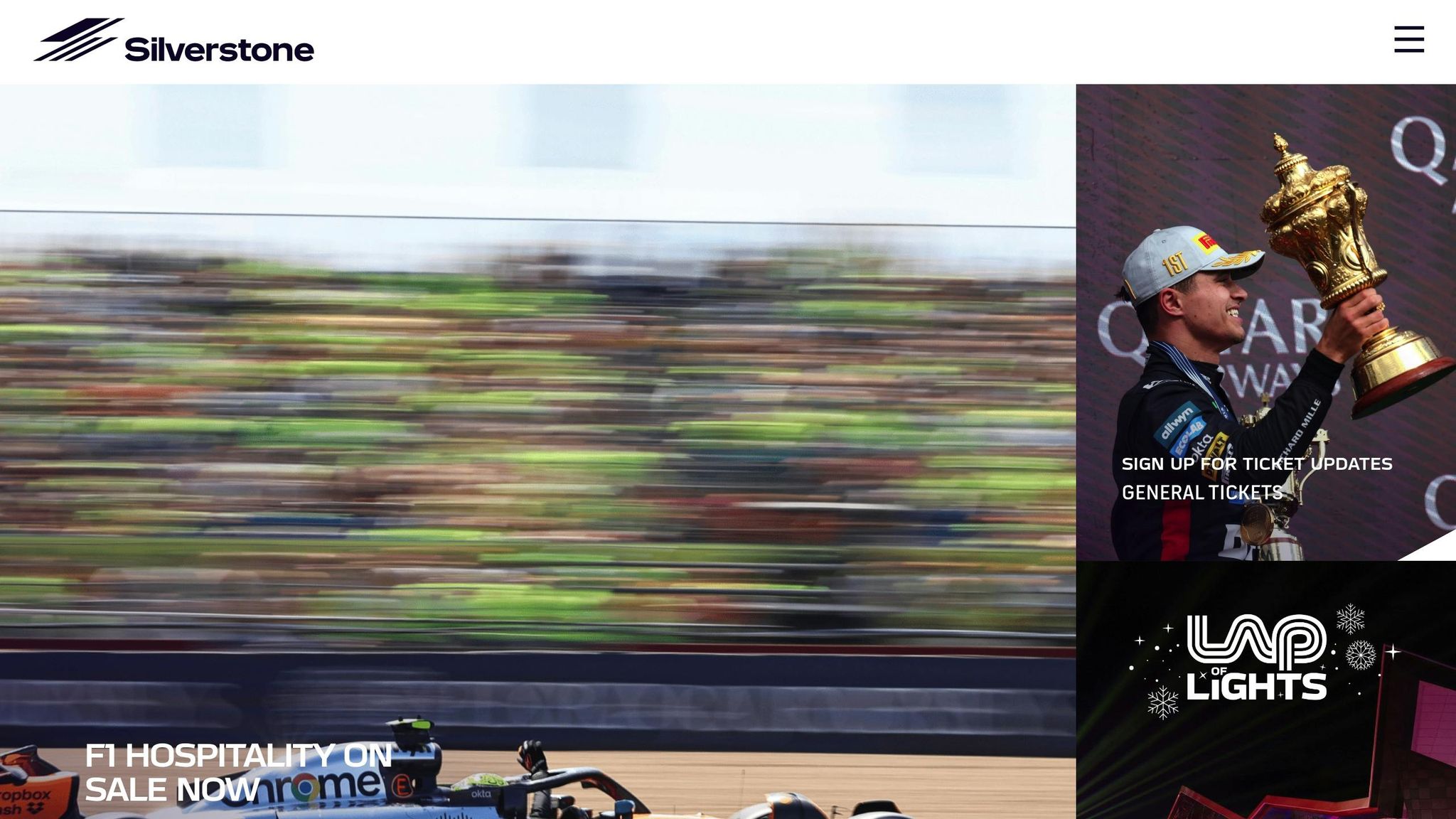
Silverstone stands out as a true test of both driver skill and machine capability. With its high-speed layout, technical demands, and aerodynamic challenges, it pushes every aspect of Formula One performance to the limit.
High-Speed Aerodynamic Challenge
Spanning 3.660 miles with 18 intense turns, Silverstone's fast and flowing design subjects cars to extreme lateral forces. These high-speed corners demand razor-sharp steering precision to maintain speed without exceeding grip thresholds.
Former Renault driver Jolyon Palmer perfectly captures the technical demands of the circuit:
"Maggots and Becketts are pretty much one corner now because your foot is nailed down throughout. The end is not quite flat, but you're happy to compromise there to get on the right part of the track for the exit."
The Aerodynamic Balancing Act
Silverstone is a battleground for aerodynamic efficiency. Teams must strike a delicate balance between generating enough downforce for the high-speed corners and minimizing drag for straight-line speed. This intricate puzzle often becomes a deciding factor in championship outcomes.
Tire Management Under Pressure
The circuit’s high-speed corners place enormous stress on tires, particularly the front-left, accelerating wear and pushing compounds to their limits. Misjudging tire selection or facing conditions that lead to graining can spell disaster. Effective tire management is critical, as the wrong choice can quickly derail a race strategy.
Weather: The Unpredictable Factor
Adding to the complexity is the famously unpredictable British weather. Race-day temperatures typically hover between 59°F and 66°F, with frequent rain threats forcing teams to adapt on the fly. As AMF1 Head of Race Strategy Peter Hall notes:
"Being on the wrong tyre for the conditions can cost as much as ten seconds."
These shifting conditions demand quick data analysis and split-second calls from the pit wall, making Silverstone a track where adaptability is as vital as speed.
A Complete Test of Car Performance
Silverstone doesn’t just favor one aspect of car performance - it demands excellence across the board. Aerodynamics, traction, straight-line speed, and tire management all come under scrutiny. The rapid direction changes also place significant importance on front suspension setups, similar to Suzuka’s first sector. Max Verstappen’s 2020 lap record of 1:27.097 is a testament to the precision required to master the circuit.
With its mix of speed, technical precision, and unpredictability, Silverstone remains one of the most challenging and rewarding tracks on the Formula One calendar.
Track Comparison Summary
Each of these circuits presents its own set of challenges, pushing drivers and teams to adapt their strategies and car setups in unique ways. Here's a side-by-side comparison of five iconic tracks, showcasing the factors that influence race outcomes:
| Circuit | Length | Corners | Elevation Change | Average Speed | Key Weather Challenge | Primary Difficulty |
|---|---|---|---|---|---|---|
| Monaco | 2.074 miles | 19 | Minimal | 93 mph | Occasional rain | Precision in tight spaces |
| Spa-Francorchamps | 4.352 miles | 20 | 335 ft | 145 mph | Frequent rain | Length and elevation |
| Marina Bay (Singapore) | 3.146 miles | 23 | Minimal | 106 mph | 82°F heat and humidity | Night racing endurance |
| Hungaroring | 2.722 miles | 14 | 125 ft | 118 mph | High temperatures | Overtaking difficulty |
| Silverstone Circuit | 3.660 miles | 18 | 98 ft | 150 mph | Unpredictable weather | High-speed precision |
This table captures the distinct characteristics of each track, offering a foundation to explore how these differences shape race strategies.
Speed Spectrum Analysis
Monaco, with its average speed of 93 mph, emphasizes mechanical grip over raw aerodynamic performance. For example, at the Fairmont hairpin, cars slow to around 31 mph before accelerating again, with top speeds reaching only about 180 mph. This narrow speed range demands setups focused on precision rather than outright speed, leaving little room for error in its tight confines.
Weather Impact Variations
Weather plays a pivotal role in differentiating these circuits. The Marina Bay Street Circuit, for instance, operates under consistent 82°F conditions, which place immense stress on cooling systems and driver endurance. In contrast, Spa-Francorchamps often faces sudden rain showers, forcing teams to adapt quickly to changing track conditions. Meanwhile, Silverstone is notorious for its unpredictable British weather, which can swing from dry to wet in minutes, adding another layer of complexity to race strategies.
Corner Complexity and Vertical Challenges
The layout of each circuit introduces its own unique demands. Marina Bay, with its 23 corners and a history of 26 safety car deployments, requires impeccable braking and acceleration precision. On the other hand, Spa-Francorchamps stands out with its dramatic 335-foot elevation change, which challenges aerodynamic balance as cars navigate its undulating terrain.
Strategic Implications
These comparisons highlight three distinct strategic categories:
- Precision Tracks: Circuits like Monaco demand flawless navigation through tight spaces, where even the smallest mistake can end a race.
- High-Speed Venues: Tracks like Spa-Francorchamps and Silverstone require aerodynamic efficiency and careful tire management to maximize speed and performance.
- Physically Demanding Circuits: Locations such as Hungaroring and Marina Bay test both driver endurance and the car's cooling systems due to extreme conditions.
Success in a championship hinges on mastering these varied challenges. Each track pushes teams to refine their setups and strategies, showcasing the incredible versatility required to compete at the highest level of motorsport.
Final Assessment
The five circuits examined in this comparison stand as the ultimate tests in Formula 1, each presenting unique challenges that demand a combination of skill, strategy, and innovation. Over the years, these tracks have played a crucial role in shaping how teams approach car design, driver preparation, and race-day tactics. This relentless pursuit of excellence has led to continuous advancements both on and off the track.
One striking example of this evolution is how aerodynamics have transformed. In the 1990s, cars relied on 40–50% of their downforce at the front, whereas today, that figure has dropped to under 30%, with over 70% now concentrated at the rear. Teams have embraced computational fluid dynamics (CFD) simulations to fine-tune car setups for the specific demands of each circuit. The diversity in track layouts requires tailored aerodynamic packages, suspension adjustments, and cooling systems to ensure optimal performance.
But it’s not just the cars that have adapted. Team strategies have also undergone significant change, with historical race data becoming a cornerstone for refining pit stops and tire management. Teams now adjust tactics in real time to respond to shifting track conditions. Drivers, too, face intense preparation, with training programs designed to build the precision, endurance, and adaptability needed to handle the tight confines of street circuits and the high-speed demands of traditional tracks.
These circuits are also shaping the future of the sport. The rise of street circuits, like Singapore's Marina Bay Street Circuit, has introduced more technical and precision-focused challenges. Drivers must adapt to unique surfaces and layouts, while teams continue to push the boundaries of aerodynamic efficiency and ride quality.
Ultimately, these tracks leave an enduring legacy by highlighting the qualities that define greatness in Formula 1. They test drivers’ precision, courage, endurance, and strategic thinking, while pushing teams to innovate and excel. As Formula 1 continues to evolve, these iconic circuits remain the ultimate proving ground, setting the stage for champions and driving the sport's technological progress.
FAQs
What makes the Circuit de Monaco one of the toughest tracks in Formula 1?
The Circuit de Monaco stands out as one of the toughest challenges in Formula 1. With its narrow streets, sharp corners, and almost no run-off areas, it demands absolute precision from drivers. A single misstep here can easily result in a crash. One of the most iconic features of the track is its famous hairpin turn, which perfectly showcases the technical expertise required to navigate this circuit.
Passing other cars on this track? Nearly impossible. That’s why qualifying performance and pit stop strategy play such a huge role. Teams need to nail their tire management and timing to squeeze out even the slightest edge. Between the tricky layout, the physical demands, and the strategic decisions, Monaco is the ultimate proving ground for both drivers and teams.
How do weather conditions affect race strategies at Spa-Francorchamps and Silverstone?
Weather is a game-changer when it comes to race strategies at both Spa-Francorchamps and Silverstone. Spa, famous for its unpredictable microclimate, keeps teams on their toes. Imagine rain drenching one part of the track while other sections stay completely dry. This kind of chaos pushes teams to make split-second decisions about tire changes, constantly weighing the risks and rewards as conditions shift in the blink of an eye.
Silverstone brings its own challenges with sudden rain showers and fluctuating temperatures that can throw tire performance and car handling into disarray. Here, teams rely heavily on weather forecasts, fine-tuning pit stop timing and tire choices to stay ahead. At both tracks, the ever-changing weather doesn’t just test strategy - it pushes drivers and teams to adapt under pressure, adding a thrilling layer of unpredictability to the race.
Why is the Marina Bay Street Circuit in Singapore considered one of the toughest tracks in Formula 1?
The Marina Bay Street Circuit stands out as one of the toughest challenges in Formula 1. Its tight, narrow layout with 19 corners demands sharp precision and exceptional driving skill. On top of that, Singapore's hot and humid weather pushes drivers to their physical extremes, while the bumpy track surface makes controlling the car even harder. Together, these elements create a race that not only pushes drivers’ endurance to the edge but also requires teams to plan their strategies meticulously. It’s a true test of grit, stamina, and teamwork.
Related posts
- Monaco Grand Prix Circuit Guide: The Prestige, Precision, and Pressure of F1’s Crown Jewel
- Suzuka’s Legacy: How Japan’s Iconic Figure-8 Circuit Became a Driver Favourite
- Spa-Francorchamps Deep Dive: The Drama, Danger, and DNA of Belgium’s Legendary Track
- 5 Iconic F1 Tracks You Must Visit for the Ultimate Racing Experience

